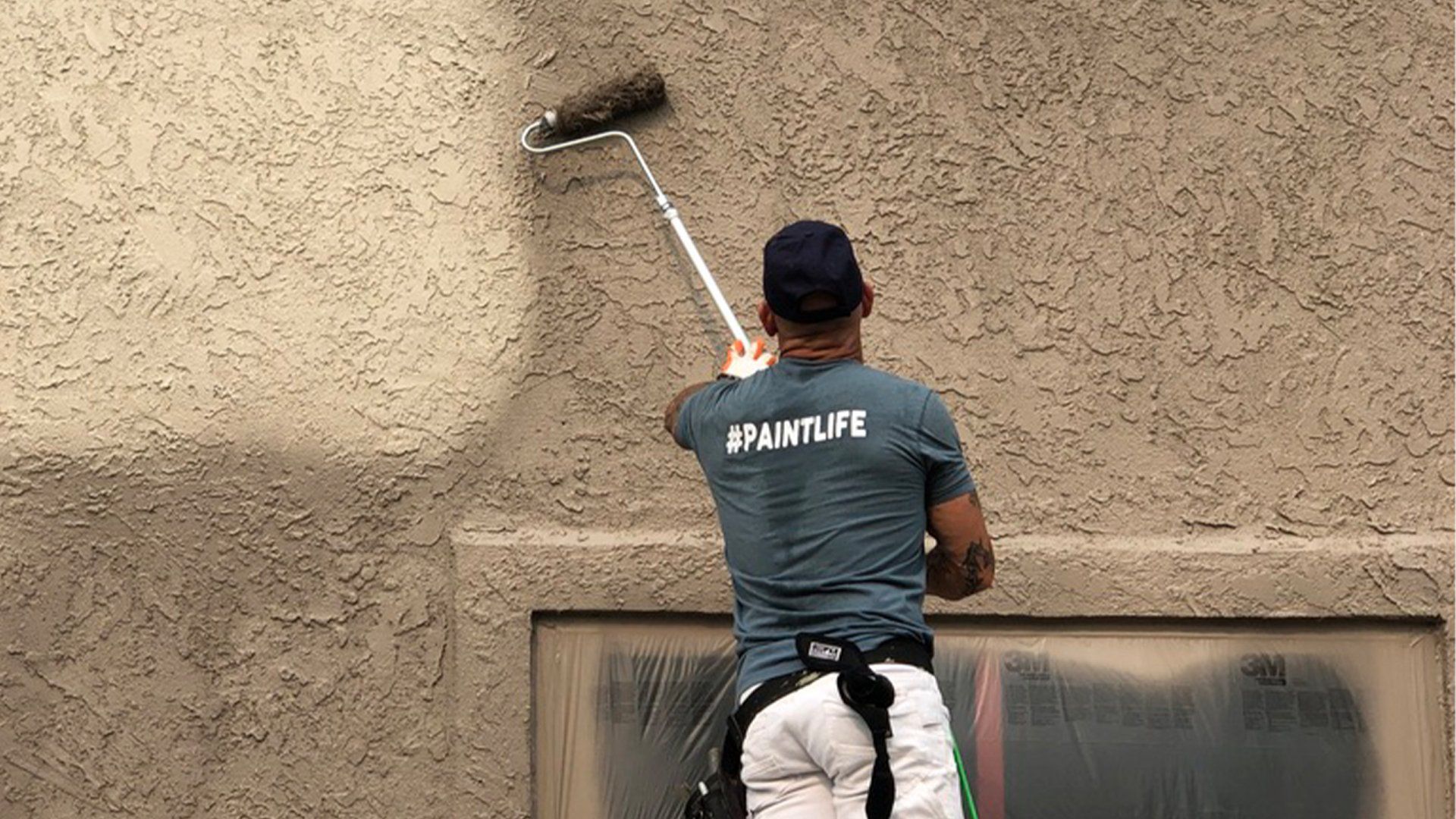Should You Back Roll Every Time?

I have painted several hundred stucco structures in my career and along the way I have learned some do’s and don’t for painting this substrate. I am going to share some things I have learned over the years that have helped me make painting stucco faster, more efficient, and effective.
First off, not all stucco is the same. Stucco comes in many forms and some stucco is easier then others to paint and some takes more prep work. Stucco in Idaho is very different then stucco in California and therefore prepping can look different. The first step is to inspect the stucco. As you inspect the stucco you need to determine if the surface is previously painted, does it have cracks, is it crumbling and deteriorating, is it a heavy texture or a light texture. After I have gathered this information I can begin determining what prep I will do and the methods I will be using to painting it.
The next step is to educate your customer to the process and product you will be using and why. I do get customers that are surprised that you can paint stucco or that there is even a need to paint it. “I thought stucco last a lifetime?” some say. It is true that stucco does have a significantly longer life span than the composite wood sided structure or even true wood sided homes. However, most clients don’t realize that the stucco has pigment added to color it and just like paint and it fades. So their beautiful stucco home will look worn and tired out in 15 years just like a painted house would.
Prior to any repairs or prep work we always give the substrate a through washing using a pressure washer and a rotating nozzle. Washing stucco takes more time and you really have to flood the surface with a lot of water to clean it. The rotating nozzle also agitates the dirt and debris to clean faster and more throughly.
Are there cracks in the stucco? How large are the cracks you will be dealing with? Do you have to do any scraping and patching? Most of the patch and prep work are straight forward but dealing with cracks can be confusing and even your worst enemy if you deal with them the wrong way. Elastomeric coatings are widely used to paint stucco and fill cracks and repair stucco.
Upon researching this coating extensively I learned that elastomeric coatings were not designed for stucco and were not created to fill cracks in stucco. The properties of the coating gives it the ability to fill hairline cracks only, and I mean hairline! The coating is very flexible and if there is any expansion and contraction in the structure any crack bigger then a hairline will re-crack. You also should not paint over an elastomeric coating, because other coatings can crack when painted over the top. You can put an elastomeric over an elastomeric but these coatings do not have nearly the color retention as high end paints so they will fade faster.
However, I like to use a additive from Rustoleum that makes paint more water resistant. The product is called Okon Paint Booster. I would choose to add paint booster to a high end flat paint, so I could get the color retention from the paint and the water resistance from the paint booster. Since I am not using a coating to fix or repair cracks I use caulking to fill them.
Caulking is a art and craft that if done improperly your cracks will look more unsightly then if you left them alone. When filling cracks I use sponges and paint brushes to blend in the caulking. I use a sanded stucco and concrete elastomeric caulking to fill the cracks. You will need to take your time and make sure you are filling the entire crack and are not skimming over it, or it will re-crack soon. As I am caulking I dab with a wet sponge and old paint brush to blend it in. If you do not do this you will have a smooth flat line across the surface, and this is usually not fixable and it will look very unsightly!
If the stucco is in good sound condition I like using a product like Duration from Sherwin Willams to paint stucco. I always use a flat paint, because I want the stucco to continue to have a stucco look after it is painted. Painting with a satin or semi-gloss sheen will add protection and this could be an option if you are in a wet climate and need moisture protection. I rarely use anything other than a high end flat paint, but there are times when using an elastomeric coating or even specialty products like Loxon would be beneficial.
What method am I going to use to paint this structure? Spray, roll, brush, spray and roll, power roll, are some options to consider. How I go about painting it is partly determined by stucco style and texture, but another major factor is if it has been previously painted.
The last stucco building I painted was previously sprayed and back rolled with paint. The back rolling of the stucco for the first time is very important as it enhance adhesion and penetration but it also helps fill pin holes and aides in getting the painting in all the crevices of the stucco. There is an infinite number of angles that need to get painted. After the first coat it is not necessary to continue to back roll.
After adhesion and penetration have been achieved on the first coat of paint then it is a matter of getting the new color in all the ins and outs. On light textured stucco spraying can achieve this. On heavy textured stucco you can spray at multiple angles or spray and back roll to achieve this. If you are woking alone spraying is more efficient to me. Stucco sucks the moisture out of the paint very fast so it is essential to load on the paint quick and having someone back roll right behind you works well. If working alone the paint usually dries too fast before you can effectively back roll it. One option if working alone is by using a Titan Inner Feed roller to apply your coating. This device, that attaches to an airless sprayer, is very effective for interior painting and for coating stucco.
Can you brush stucco? Probably an impossible task. I would not even try and you will probably go through several boxes of brushes to complete the project. Getting back to the last project I painted, the stucco was previously painted and I was going to use an Inner Feed roller. The texture was very heavy and I was working alone so I quickly learned it would be faster and more effective spraying it. On a lighter textured stucco the Inner Feed roller would have been perfect. It would also been the best option if I had a partner working with me.
If you are spraying heavy textured stucco spraying slightly up, face on, angled to the right, angled to the left, and top down will have to be achieved if full coverage and total color change is going to happen. Painting stucco is going to take significantly longer than a typical composite or wood sided house and it will take at least double the paint for coverage, so bid it properly, so you do not lose your shorts!
Stucco by nature needs to be back rolled on the first coat in all texture styles. If you are spraying an elastomeric coating to help resolve damaged or cracked stucco I spray and back roll two very heavy coats of product. Using paint I like spraying the stucco with a 517 tip. If I am spraying an elastomeric coating I like using a 619 tip. Another draw back to elastomeric is that you need to spray and back roll several heavy coats therefore eliminating some of the texture of the stucco making it look smoother. When back rolling you need to use a roller with 3/4 or 1” nap.
Most importantly, be patient when painting stucco and keep your rollers and sprayers loaded up and ready to go all day. This will not be one and done. You will notice as the sun moves and the lighting changes missed crevices will be revealed. You have to work around the structure up and down in different lighting. Eventually you will find what works for you painting stucco. Every situation posses different challenges.
You can visit our Paint Life store for cool gifts for your favorite painters, Paint Life apparel, and get game changing tools for all your painting jobs. Enter store HERE.



